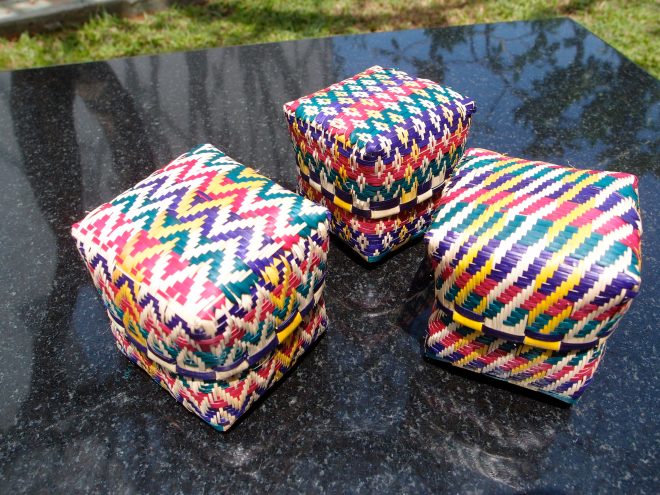You know those oriental goddesses, like Kali or Guanyin, that have several pairs of arms? I think I met a real-life incarnation in Sri Lanka.
Meet Soma Edirisinghe, who makes incredibly delicate purses, boxes and bags from indikola, a kind of palm. The tender leaves are picked, bleached or dyed, dried, and cut into thin strips. You can see her holding some in the photo above, along with some of her products (more close-up shots below).
She uses a long metal needle called a bodkin, pointed at one end and with a cutting edge at the other, to help manipulate these incredibly delicate strips – some no more than 1mm wide.
Soma could see I was fascinated by watching her work, so she gesticulated that she would show me how to make a simple box. (She spoke no English and, needless to say, my Sinhala was not up to this.) So with sign language only, we set to work.
Now, I did make a woven basket last term at Morley College. But it was made from cardboard, on a much larger scale, and I used clothes pegs and masking tape to help keep the strips in place. By contrast, Soma used just her hands and the bodkin to do everything. Which is why she seemed to have more than one pair of hands – when I was in the middle of making the box, I certainly felt as if I needed at least two more pairs!
First she takes a leaf of indikola and scrapes both sides along the length of the needle (a bit like using scissors to curl a strip of paper – only in this case it is to straighten the palm, not curl it). Because the leaf is thicker at one end (where it was attached to the stalk) and tapers to a point, it’s not of uniform width. So she cuts off the thick end, and uses the point of the bodkin to slice thin strips off each side of the leaf so that the width is more consistent. The art is to get all the strips the same width – which isn’t as easy as it sounds, as it’s quite tricky to get the leaf to split exactly where you want it!
While I was attempting to get 10 strips about 1cm wide, Soma was preparing five much narrower strips – about a third of this width. Then I lined up five wide strips vertically, alternating the thick and thin ends. Using just the weight of the needle to keep them in position (no masking tape here!), Soma then helped me weave five wide strips horizontally through the vertical strips, again alternating thick and thin ends. Then we added five narrow strips at the top.
Now the fun began. Faster than you can say “Where does that bit go?”, Soma had formed the corners and indicated that I should carry on weaving. This was really tricky, trying to keep the bits I had already woven in position just using my hands without the help of clothes pegs. As you can see, I did have some help!
When I had woven three vertical rows with the wider strips, Soma showed me how to weave in the narrow strips to form a decorative border. Then I was ready to finish off, weaving the ends in and cutting off the ends. Success!
Unfortunately, I didn’t have time to make the top of the box (you can see a complete one among the products in Soma’s photo), as I had to go off and interview some other craftworkers. But I had a great time, and I think Soma did too. Despite all the help she gave me she said I was a natural – so I had to confess that I had done something like this before, though not on such a small scale.
Soma has won Unesco and Presidential Awards for her skills – and justly so. I can only admire her skill and dexterity in handling these delicate strips of indikola – not to mention the beautiful designs and colours – she dyes the leaves herself.






Hi Kim
….yes you are a natural !!! thank you for the pictures and report !!
have a nice weekend !
Silvia